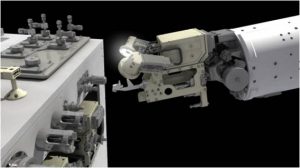
Illustration of the Wire Cutter and Blanket Manipulation Tool preparing to cut wire on a sealed cap on the RRM box (Credits: NASA).
NASA has successfully completed another set of experiments in its Robotic Refueling Mission (RRM), which aims to validate the use of technologies required for in-orbit refueling of satellites. The experiments, part of the Gas Fittings Removal Task (the second out of a total of six), continued the work performed earlier this year.
“We’re hoping, by doing these demonstrations, that we’re enabling the technology to move forward and do these things outside the Space Station, in Low Earth Orbit or Geo-Synchronous Orbit” said Jill McGuire, Project Manager for RRM.
The RRM consists of a payload module – a set of typical satellite fueling interfaces – and a set of four tools, which were launched to the ISS aboard the last Space Shuttle flight. The tools are fitted to the Canadian Space Agency’s Special Purpose Dexterous Manipulator (SPDM/Dextre) and the operations are conducted from ground.
The test involved using the Multifunction Tool (MFT) to remove a valve and two caps. These are usually placed on the spacecraft after it has been fueled on ground, and need to be removed in order to access the spacecraft’s fill-and-drain valve.
The technologies and techniques being used in the RRM will enable not only refueling of spacecraft, but also repair – spacecraft with non-deployed solar arrays, for instance, may be able to be rescued from mission failure. The tools can also be used on spacecraft that were not designed for in-orbit servicing.
With the Gas Fitting Removal Task successfully concluded, the Robotic Refueling Mission is scheduled to continue with the refueling itself in August.
Below, an interview with RRM project manager Jill McGuire:

















































































































![A trajectory analysis that used a computational fluid dynamics approach to determine the likely position and velocity histories of the foam (Credits: NASA Ref [1] p61).](http://www.spacesafetymagazine.com/wp-content/uploads/2014/05/fluid-dynamics-trajectory-analysis-50x50.jpg)



Leave a Reply